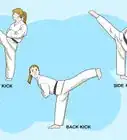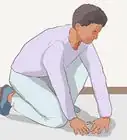This article was co-authored by Yvonne Mo. Yvonne Mo is a Fitness and Health Coach and Kung Fu Instructor. With more than 21 years of fitness industry and martial arts experience, she specializes in combining and teaching eastern and western fitness and health modalities, which include Tai Chi, sports acupuncture, Chinese medicine, and fire cupping. Yvonne received her Personal Trainer Certifications through both the National Strength and Conditioning Association and the American College of Sports Medicine.
There are 8 references cited in this article, which can be found at the bottom of the page.
wikiHow marks an article as reader-approved once it receives enough positive feedback. This article received 23 testimonials and 82% of readers who voted found it helpful, earning it our reader-approved status.
This article has been viewed 1,894,213 times.
The philosophy behind karate is vast and complex. It stems from thousands of years of armed and unarmed combat. Techniques that were perfected hundreds of years ago are still being perfected over and over again by each new generation. Buddhism, Taoism, and the code of Bushido have all played parts in the development of the martial arts philosophy. Karate in its modern form was established around 400 years ago in Japan, with its roots mainly derived from Chinese Kung Fu. See Step 1 below to start teaching yourself the basics of this art form.
Steps
Getting in the Zone
-
1Meditate. (5+ minutes) Clear your mind of all thoughts; concentrate on breathing in through the nose, out through the mouth; steady deep breaths and a clear mind will prepare you to learn Karate. There is no time limit, but meditating for at least 5 minutes should clear your thoughts enough to allow you to concentrate. And yes, meditating can definitely enhance your fighting skills![1]
- Forget school. Forget work. Forget family, problems, everything -- visualize them evaporating before your eyes. Once everything is gone, you should see an empty room, and in the center of the empty room, a ball of flame begins growing from the emptiness. This flame of firing strength and energy should represent anything you hope to achieve by training yourself in Karate. By the time you are done with your meditation, the room should be entirely engulfed by nothing but the flame.
-
2Warm up. (10 minutes) Start off by running in place or around the block for about 5 minutes; plus about 5 minutes (or 20 reps each) of push-ups, sit-ups (or crunches), leg lifts, and reverse push-ups.[2]
- Warming up is vital to your muscles' ability to do work. If you don't get them loose and ready before you start your training and stretching, then they will go on strike against you and even basic moves will be tough to execute properly.
Advertisement -
3Stretch. (15 minutes) Stretching all major muscle groups first is essential for a loose and limber body; get a book on stretching if you do not already know what stretching exercises to do. In Karate, stretching the legs is crucial to keep yourself injury-free.[3]
- Stretching comes after warming up. When your muscles have heated up, that's when they'll be most receptive to stretching -- when stretching will be the safest and most effective.
-
4Understand the philosophy behind karate. To the untrained observer, karate may look like its about showy displays of violence. In fact, it's the polar opposite. Karate is about peace and, what's more, peace of mind. In life conflict is unavoidable. When this happens, it should be handled swiftly and with power. The result is a natural confidence that has an air of humility.[4]
- This is an art form that involves the mind and spirit as much as the body. All three must develop simultaneously for the practitioner to truly master this sport. While the body must remember how to move, the mind, in turn, must remember how to be still.
- All of the martial arts begin and end with courtesy. There is very little that is selfish about karate. It is believed that in your devotion there is reward.
Mastering Stances, Balance, and Power
-
1Get the basic stances down. Yeah, yeah, yeah, you wanna get to the fun stuff. Unfortunately, your kicks, strikes, and blocks will not be effective if you don't have your stance right. You wouldn't expect to be a great baseball player if you held your bat the wrong way, would you? Nope. The basics are what truly make a great karateka (karate practitioner).[5]
- There are different types of Karate. You'll find different stances are traditional depending on which type you're practicing. Most types of karate have some variation of the following three stances:[6]
- The natural, or walking stance (shizentai-dachi) is when your front foot is pointing forward, back foot is out at a 45-degree angle pointing behind you. Your feet are apart at a natural, or walking, width.
- The front stance (zenkutsu-dachi) is like the natural stance, but your feet are further apart and your weight is mostly on your front leg.
- Cat stance, or back stance (nekoashi-dachi). Your foot positioning is like the walking stance, but your weight is mostly on your back leg. Your front heel, if you so choose, may be raised.
- There are different types of Karate. You'll find different stances are traditional depending on which type you're practicing. Most types of karate have some variation of the following three stances:[6]
-
2Start with the ready stance. The stances above are fighting stances. However, at the beginning of any spar, you'll need to begin with the ready stance. You have three basic options:[7]
- The ready stance in the Fukyugata series has the heels together and toes pointing outward at a 60-degree angle.
- The ready stance in the Pinan series has the feet at shoulder width, toes pointing outward at a 45-degree angle.
- The ready stance in the Naihanchi series has the feet directly together and parallel.
-
3Be aware of your balance. Karate isn't exactly something drunk people would be good at, and for good reason -- it takes an immense ability to balance. That's part of the reason the stances are so important! They center your body, allowing you to be fluid while simultaneously strong. But that strength you feel in your stance can't disappear when you start kicking![8]
- Always think about your center gravity. If you spread your feet, you lower it, proving yourself stability and more bang for your attack. But if you lower it too much, you lose mobility and speed. When it comes to balance, there is a happy medium you need to find.
- While having balance is important, when you start having to defend yourself, you'll need to be able to shift that balance quite quickly as well. If you're in one stance too long, your opponent can easily attack you! Because of this, transitions between stances are important too.
-
4Concentrate on your power and speed. There are plenty of people (read: gym rats) who lift hundreds and hundreds of pounds but yet would not excel at karate. It is not about muscle -- it's about power and speed.
- The two are highly connected. A longer route to your target will help you develop more speed and thus power. If you use your entire body, you will have more power behind your attack, and necessarily employ more speed. However, think of karate not as being able to move a large object, but being able to move a small object quickly and with detailed precision.
Mastering the Moves
-
1Work on your punching and blocking. (15 minutes) There are a few essential punches you will need to learn to attack effectively. The straight punch, upper-cut, knife-hand, spear-hand, elbow strike, and backfist, namely. Practice them in order and alternate hands.
- Blocking is just as important! Practice blocking as though these were the punches you were being attacked with. Experiment with combinations and counter attacks. Defend, attack, defend, attack...etc.
- For the record, your first two knuckles are the strongest knuckles on your hand. They can be lined up with your forearm bones (radius and ulna) to increase strength. The most common mistakes are when people have a crooked fist, punch too high or punch with their shoulder.
-
2Practice kicking. (15 minutes) Ten repetitions of any kick will suffice in strengthening your legs. Focus beyond the target for maximum power, but practice the flow of motion to gain graceful fluidity in your movements; like a swan; power will follow.
- There are five basic karate kicks:
- The front snap kick. Basically, think of your foot swinging out in front of you like you're snapping a towel. In natural stance, you draw up your back foot, bend at the knee, and snap (hence the name) your leg out in front of you and draw it immediately back to where it was.
- The side snap kick. The same as the front snap kick...only to the side.
- The side trust kick. Lift your kicking foot to your opposite knee, kick, and roll your hip forward. In the snap kicks, your torso stays upright. In trust kicks, your torso falls more in line with your kicking leg, coming down to power your kicking leg upward.
- The guy in the gif above is doing a trust kick. See how his torso comes down?
- The back trust kick. Like the side trust kick, but you're looking behind you and kicking in the same direction as you're looking.
- The round kick. In cat stance, pull your kicking leg up toward the same elbow. Swing your hips forward and pivot, creating the "round" in the round kick. Then snap it back as quickly as possible.
-
3Start sparring. (15+ minutes) Find someone to practice with, and use all of your techniques to fight them for 15 to 30 minutes. Sparring will help you increase your stamina and ability to throw combinations and defend yourself against multiple attacks or multiple attackers, once you've mastered certain blocking and attacking techniques.
-
4Practice all kata (literally, "practice form") over and over. Focus on one kata in particular for that session. Once you have it, you can move on. It's important to focus on lower level kata as well as higher level to refine and improve.[9]
- Be sure to revisit it once you do have it! After you master several, piece them together and work on increasingly difficult combinations as the days progress.
Karate Stances, Moves, and Routine
Community Q&A
-
QuestionHow can I become more strong?
 wikiHow Staff EditorThis answer was written by one of our trained team of researchers who validated it for accuracy and comprehensiveness.
wikiHow Staff EditorThis answer was written by one of our trained team of researchers who validated it for accuracy and comprehensiveness.
Staff Answer wikiHow Staff EditorStaff AnswerYou can get stronger through exercise, weight training, eating a healthy diet filled with nutrients and by developing a workout aimed at strengthening particular parts of your body. There is a lot to this topic that a short answer can't fulfill, so for more help with this topic, see How to Get Strong.
wikiHow Staff EditorStaff AnswerYou can get stronger through exercise, weight training, eating a healthy diet filled with nutrients and by developing a workout aimed at strengthening particular parts of your body. There is a lot to this topic that a short answer can't fulfill, so for more help with this topic, see How to Get Strong. -
QuestionCan I teach myself martial arts?
 wikiHow Staff EditorThis answer was written by one of our trained team of researchers who validated it for accuracy and comprehensiveness.
wikiHow Staff EditorThis answer was written by one of our trained team of researchers who validated it for accuracy and comprehensiveness.
Staff Answer wikiHow Staff EditorStaff AnswerIt is best to learn martial arts from properly trained professionals and to have classmates with whom you can interact and learn proper defense (and where relevant offense) techniques, which is not possible by yourself. That said, some basic moves and beginner learning can be done by yourself in preparation for starting or practicing for a martial arts class. For more information, see How to Teach Yourself Martial Arts.
wikiHow Staff EditorStaff AnswerIt is best to learn martial arts from properly trained professionals and to have classmates with whom you can interact and learn proper defense (and where relevant offense) techniques, which is not possible by yourself. That said, some basic moves and beginner learning can be done by yourself in preparation for starting or practicing for a martial arts class. For more information, see How to Teach Yourself Martial Arts. -
QuestionWhat is the best age to start martial arts?
 wikiHow Staff EditorThis answer was written by one of our trained team of researchers who validated it for accuracy and comprehensiveness.
wikiHow Staff EditorThis answer was written by one of our trained team of researchers who validated it for accuracy and comprehensiveness.
Staff Answer wikiHow Staff EditorStaff AnswerThe answer depends on the type of martial arts and the rules of the school or dojo. It also depends on how ready the child is––for martial arts, a child should be able to follow rules, be well coordinated, have the ability to focus well and be willing to participate. Some schools will accept toddlers in special classes focused on easy moves and games, while other schools prefer children to be at least in primary/elementary school, while still attuning the classes to a child’s abilities. While it is a good idea to start a child young, gauge the suitability from the child’s own level of readiness and clearly expressed interest, and talk to the school or dojo you think might suit your child to find out what age they consider appropriate.
wikiHow Staff EditorStaff AnswerThe answer depends on the type of martial arts and the rules of the school or dojo. It also depends on how ready the child is––for martial arts, a child should be able to follow rules, be well coordinated, have the ability to focus well and be willing to participate. Some schools will accept toddlers in special classes focused on easy moves and games, while other schools prefer children to be at least in primary/elementary school, while still attuning the classes to a child’s abilities. While it is a good idea to start a child young, gauge the suitability from the child’s own level of readiness and clearly expressed interest, and talk to the school or dojo you think might suit your child to find out what age they consider appropriate.
Warnings
- Remember your sparring partner is real, not a punching bag. Safety gear is advised and always be careful.⧼thumbs_response⧽
- When blocking a kick or punch from a sparring opponent, always remember to block with the forearm.⧼thumbs_response⧽
- Always stretch, and stretch everything. Pulling a muscle or snapping a tendon is excruciatingly painful!⧼thumbs_response⧽
References
- ↑ http://fightingarts.com/reading/article.php?id=345
- ↑ https://www.verywellfit.com/how-to-warm-up-before-exercise-3119266
- ↑ https://www.health.harvard.edu/staying-healthy/the-importance-of-stretching
- ↑ https://www.jka.or.jp/en/about-jka/philosophy/
- ↑ http://www.karatebyjesse.com/the-stances-of-karate-form-function-and-footprints/
- ↑ http://www.dynamic-karate.com/basic-karate-moves.html
- ↑ https://kenzenichii.org/stances.html
- ↑ https://www.ncbi.nlm.nih.gov/pmc/articles/PMC5742172/
- ↑ http://www.imakarate.com/student-information/list-of-katas/
About This Article
To teach yourself the basics of Karate, work on punching, such as the straight punch, upper-cut, knife-hand, spear-hand, elbow strike, and backfist. Also, make sure to work on your blocking, as this is just as important. For kicks, practice your front snap kick, side snap kick, and side trust kick. Once you feel comfortable with a variety of moves, find someone to try sparring with for 15 to 30 minutes. This will help you build stamina as well as learn new combinations and techniques. If you want to learn more about stances and how to practice form, keep reading the article!

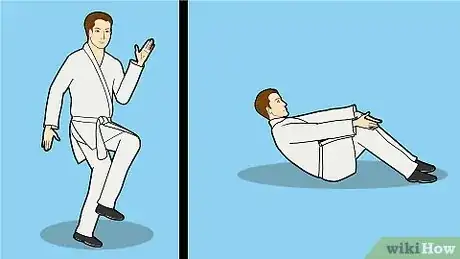
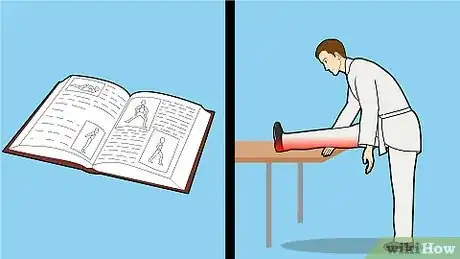
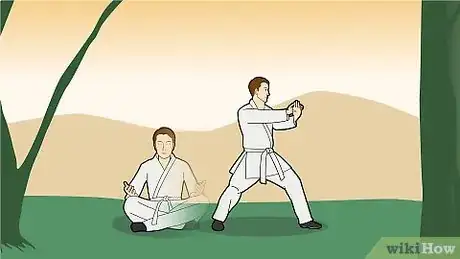



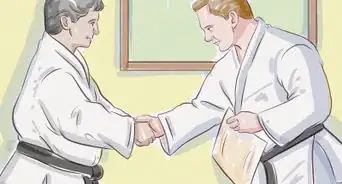
-Step-15-Version-2.webp)
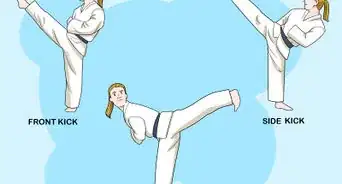

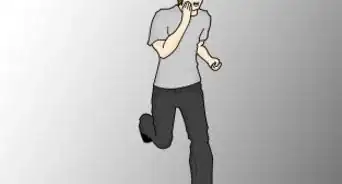
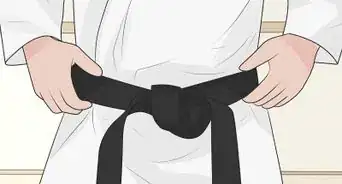

-Step-7-Version-2.webp)
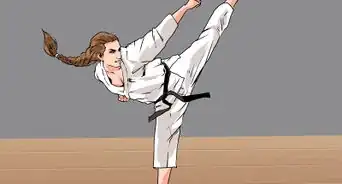
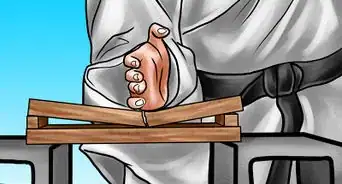

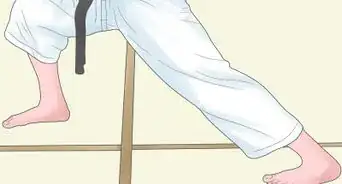
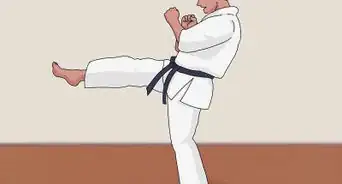










-Step-15-Version-2.webp)
